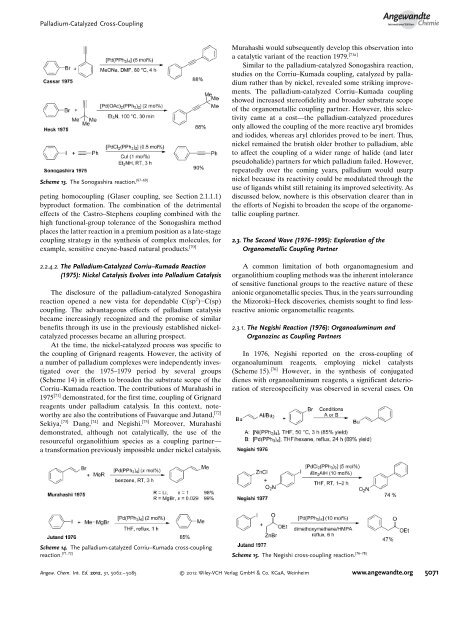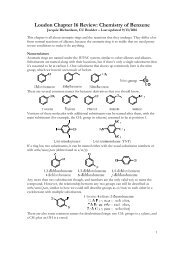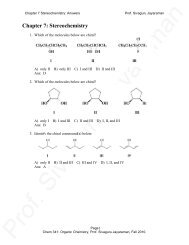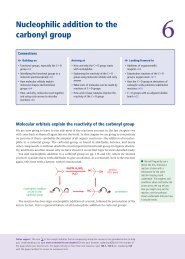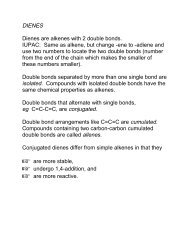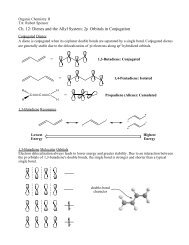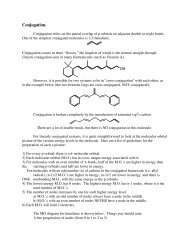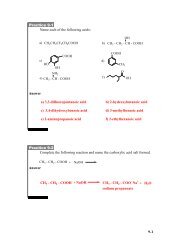<strong>Palladium</strong>-<strong>Catalyzed</strong> <strong>Cross</strong>-<strong>Coupling</strong>AngewandteChemieScheme 13. The Sonogashira reaction. [67–69]peting homocoupling (Glaser coupling, see Section 2.1.1.1)byproduct formation. The combination of <strong>the</strong> detrimentaleffects of <strong>the</strong> Castro–Stephens coupling combined with <strong>the</strong>high functional-group <strong>to</strong>lerance of <strong>the</strong> Sonogashira methodplaces <strong>the</strong> latter reaction in a premium position as a late-stagecoupling strategy in <strong>the</strong> syn<strong>the</strong>sis of complex molecules, forexample, sensitive eneyne-based natural products. [70]2.2.4.2. The <strong>Palladium</strong>-<strong>Catalyzed</strong> Corriu–Kumada Reaction(1975): Nickel Catalysis Evolves in<strong>to</strong> <strong>Palladium</strong> CatalysisThe disclosure of <strong>the</strong> palladium-catalyzed Sonogashirareaction opened a new vista for dependable C(sp 2 ) C(sp)coupling. The advantageous effects of palladium catalysisbecame increasingly recognized and <strong>the</strong> promise of similarbenefits through its use in <strong>the</strong> previously established nickelcatalyzedprocesses became an alluring prospect.At <strong>the</strong> time, <strong>the</strong> nickel-catalyzed process was specific <strong>to</strong><strong>the</strong> coupling of Grignard reagents. However, <strong>the</strong> activity ofa number of palladium complexes were independently investigatedover <strong>the</strong> 1975–1979 period by several groups(Scheme 14) in efforts <strong>to</strong> broaden <strong>the</strong> substrate scope of <strong>the</strong>Corriu–Kumada reaction. The contributions of Murahashi in1975 [71] demonstrated, for <strong>the</strong> first time, coupling of Grignardreagents under palladium catalysis. In this context, noteworthyare also <strong>the</strong> contributions of Fauvarque and Jutand, [72]Sekiya, [73] Dang, [74] and Negishi. [75] Moreover, Murahashidemonstrated, although not catalytically, <strong>the</strong> use of <strong>the</strong>resourceful organolithium species as a coupling partner—a transformation previously impossible under nickel catalysis.Murahashi would subsequently develop this observation in<strong>to</strong>a catalytic variant of <strong>the</strong> reaction 1979. [71a]Similar <strong>to</strong> <strong>the</strong> palladium-catalyzed Sonogashira reaction,studies on <strong>the</strong> Corriu–Kumada coupling, catalyzed by palladiumra<strong>the</strong>r than by nickel, revealed some striking improvements.The palladium-catalyzed Corriu–Kumada couplingshowed increased stereofidelity and broader substrate scopeof <strong>the</strong> organometallic coupling partner. However, this selectivitycame at a cost—<strong>the</strong> palladium-catalyzed proceduresonly allowed <strong>the</strong> coupling of <strong>the</strong> more reactive aryl bromidesand iodides, whereas aryl chlorides proved <strong>to</strong> be inert. Thus,nickel remained <strong>the</strong> brutish older bro<strong>the</strong>r <strong>to</strong> palladium, able<strong>to</strong> affect <strong>the</strong> coupling of a wider range of halide (and laterpseudohalide) partners for which palladium failed. However,repeatedly over <strong>the</strong> coming years, palladium would usurpnickel because its reactivity could be modulated through <strong>the</strong>use of ligands whilst still retaining its improved selectivity. Asdiscussed below, nowhere is this observation clearer than in<strong>the</strong> efforts of Negishi <strong>to</strong> broaden <strong>the</strong> scope of <strong>the</strong> organometalliccoupling partner.2.3. The Second Wave (1976–1995): Exploration of <strong>the</strong>Organometallic <strong>Coupling</strong> PartnerA common limitation of both organomagnesium andorganolithium coupling methods was <strong>the</strong> inherent in<strong>to</strong>leranceof sensitive functional groups <strong>to</strong> <strong>the</strong> reactive nature of <strong>the</strong>seanionic organometallic species. Thus, in <strong>the</strong> years surrounding<strong>the</strong> Mizoroki–Heck discoveries, chemists sought <strong>to</strong> find lessreactiveanionic organometallic reagents.2.3.1. The Negishi Reaction (1976): Organoaluminum andOrganozinc as <strong>Coupling</strong> PartnersIn 1976, Negishi reported on <strong>the</strong> cross-coupling oforganoaluminum reagents, employing nickel catalysts(Scheme 15). [76] However, in <strong>the</strong> syn<strong>the</strong>sis of conjugateddienes with organoaluminum reagents, a significant deteriorationof stereospecificity was observed in several cases. OnScheme 14. The palladium-catalyzed Corriu–Kumada cross-couplingreaction. [71, 72] Scheme 15. The Negishi cross-coupling reaction. [76–78]Angew. Chem. Int. Ed. 2012, 51, 5062 – 5085 2012 Wiley-VCH Verlag GmbH & Co. KGaA, Weinheim www.angewandte.org5071
Angewandte .Reviewssubstituting <strong>the</strong> nickel catalysts by palladium complexes, thisdrawback was eliminated. Subsequently, Negishi [77] andFauvarque and Jutand [78] reported <strong>the</strong> use of zinc reagentsin cross-coupling reactions (Scheme 15). Most significantly,<strong>the</strong> discoveries that organoaluminum intermediates and zincreagents serve as coupling partners showed that magnesiumand lithium could be replaced with o<strong>the</strong>r metals that werecapable of participating in <strong>the</strong> proposed transmetallation step.Somewhat anticipa<strong>to</strong>ry of <strong>the</strong> future, Negishi and co-workerscarried out metal-screening regimens <strong>to</strong> identify o<strong>the</strong>rpossible organometallic reagents as coupling partners. [79] Asa result, <strong>the</strong> [PdCl 2 (PPh 3 ) 2 ]-catalyzed coupling of an aryliodide with zinc-, boron-, and tin-based acetylene organometallicspecies <strong>to</strong> give <strong>the</strong> alkyne products was successfullyachieved (Table 1).T. J. Colacot, V. Snieckus et al.fur<strong>the</strong>r coupling under <strong>the</strong> reaction conditions, and <strong>the</strong> nextbreakthrough would come from <strong>the</strong> use of organotin reagents.In a seminal report in 1976, Eaborn disclosed <strong>the</strong> firstpalladium-catalyzed cross-coupling of organodistannanereagents with aryl iodides (Scheme 16). In this report animportant side reaction was noted—dimerization of <strong>the</strong> arylhalide component. [83] Shortly <strong>the</strong>reafter, Migita reported on<strong>the</strong> palladium-catalyzed cross-couplings of organotin reagentswith aryl bromides. [84]Following <strong>the</strong> initial reports of Eaborn and Migita, Stilleand Milstein unveiled, in 1978, <strong>the</strong> syn<strong>the</strong>sis of ke<strong>to</strong>nes [85] by<strong>the</strong> coupling of aroyl chlorides with organostannanes(Scheme 16) under significantly milder reaction conditionsthan those reported by Migita and Kosugi. In <strong>the</strong> early 1980s,Stille fur<strong>the</strong>r explored and improved this reaction, developingTable 1: <strong>Coupling</strong> reactions of zinc, boron, and tin acetylides with an aryliodide. [80]Metal T [8 C] t [h] Yield [%] [a]Product Starting materialLi 25 1 trace 88Li 25 24 3 80MgBr 25 24 49 33ZnCl 25 1 91 8HgCl 25 1 trace 92HgCl reflux 6 trace 88BBu 3 Li 25 3 10 76BBu 3 Li reflux 1 92 5AliBu 2 25 3 49 46AlBu 3 Li 25 3 4 80AlBu 3 Li reflux 1 38 10SiMe 3 reflux 1 trace 94SnBu 3 25 1 75 14SnBu 3 25 6 83 6ZrCp 2 Cl 25 1 0 91ZrCp 2 Cl reflux 3 0 80[a] Conditions giving best yields are highlighted.In <strong>the</strong> hands of Negishi and his students, <strong>the</strong> field ofpalladium- and nickel-catalyzed coupling reactions of unsaturatedorganic halides with organozinc reagents evolved in<strong>to</strong>a general reaction which now stands out as a mild route withimpressive functional-group compatibility. [77b] With <strong>the</strong> demonstrationof <strong>the</strong> reactivity of alternative organometallicderivatives, Negishi significantly broadened <strong>the</strong> concept of<strong>the</strong> cross-coupling approach and set <strong>the</strong> stage for <strong>the</strong>uncovering of milder, less electropositive-metal couplingspecies.2.3.2. The Stille Reaction (1976–1978): Organostannane <strong>Coupling</strong>PartnersIn 1973, Atwell and Bokermen demonstrated that <strong>the</strong>reaction of allyl halides with a disilane under palladiumcatalysis furnished <strong>the</strong> corresponding organosilane derivatives.[81] Subsequently, Matsumo<strong>to</strong> showed that aryl bromidesunderwent <strong>the</strong> analogous reaction with hexamethyldisilane. [82]However, <strong>the</strong>se organosilanes were not observed <strong>to</strong> undergoScheme 16. The seminal stannane cross-coupling discoveries. [83–85]it in<strong>to</strong> a highly versatile methodology displaying remarkablybroad functional-group compatibility and, by demonstratingits utility in <strong>to</strong>tal syn<strong>the</strong>ses, changed <strong>the</strong> ways that chemiststhought about C C bond construction. [86] In this context,Beletskayas contributions <strong>to</strong> palladium-catalyzed cross-couplingreactions using aryl tin reagents have not receivedsufficient recognition owing <strong>to</strong> <strong>the</strong>ir initial publication in <strong>the</strong>Russian literature. [87] Without argument, <strong>the</strong> main disadvantageof <strong>the</strong> Migita–Stille reaction is <strong>the</strong> <strong>to</strong>xicity of <strong>the</strong>organostannanes. However, despite <strong>the</strong> <strong>to</strong>xicity issue, thisreaction enjoys fourth place in terms of publications andpatents in <strong>the</strong> last decade (Figure 2). [88] To address <strong>the</strong>problems of <strong>to</strong>xicity, <strong>the</strong> range of organometallic couplingpartners would need <strong>to</strong> be expanded fur<strong>the</strong>r.2.3.3. The Suzuki–Miyaura Reaction (1979): Activated Organoboranesas <strong>Coupling</strong> PartnersIn 1979 Suzuki, having recently returned <strong>to</strong> Japan from hispostdoc<strong>to</strong>ral studies with H. C. Brown, pursued <strong>the</strong> remainingelement of <strong>the</strong> three identified by Negishi (zinc, boron, andtin) and reported <strong>the</strong> palladium-catalyzed cross-couplingbetween 1-alkenylboranes and aryl halides (Scheme 17). [89]Interestingly, Heck had observed in 1975 that boronic acidsare competent cross-coupling partners when s<strong>to</strong>ichiometricquantities of palladium are employed. [90] However, it would beSuzukis demonstration that this chemistry could be moved5072 www.angewandte.org 2012 Wiley-VCH Verlag GmbH & Co. KGaA, Weinheim Angew. Chem. Int. Ed. 2012, 51, 5062 – 5085


